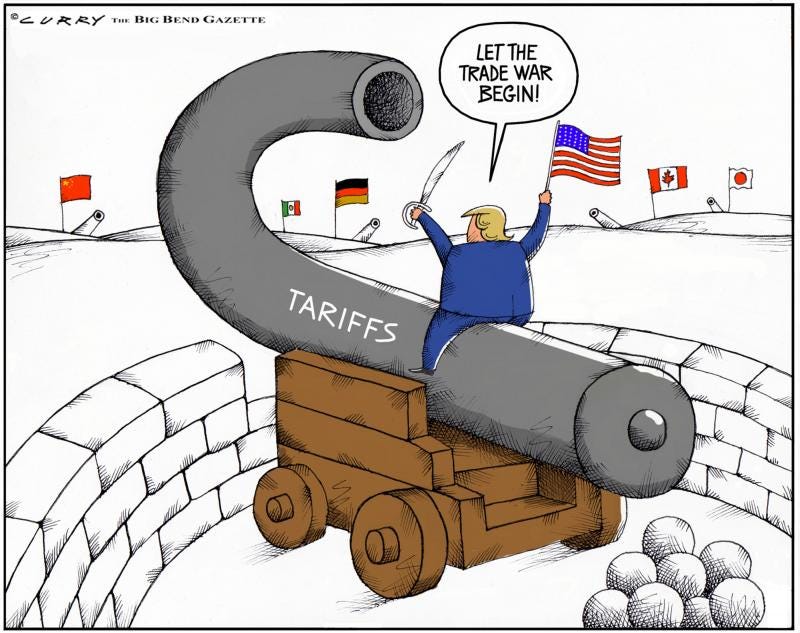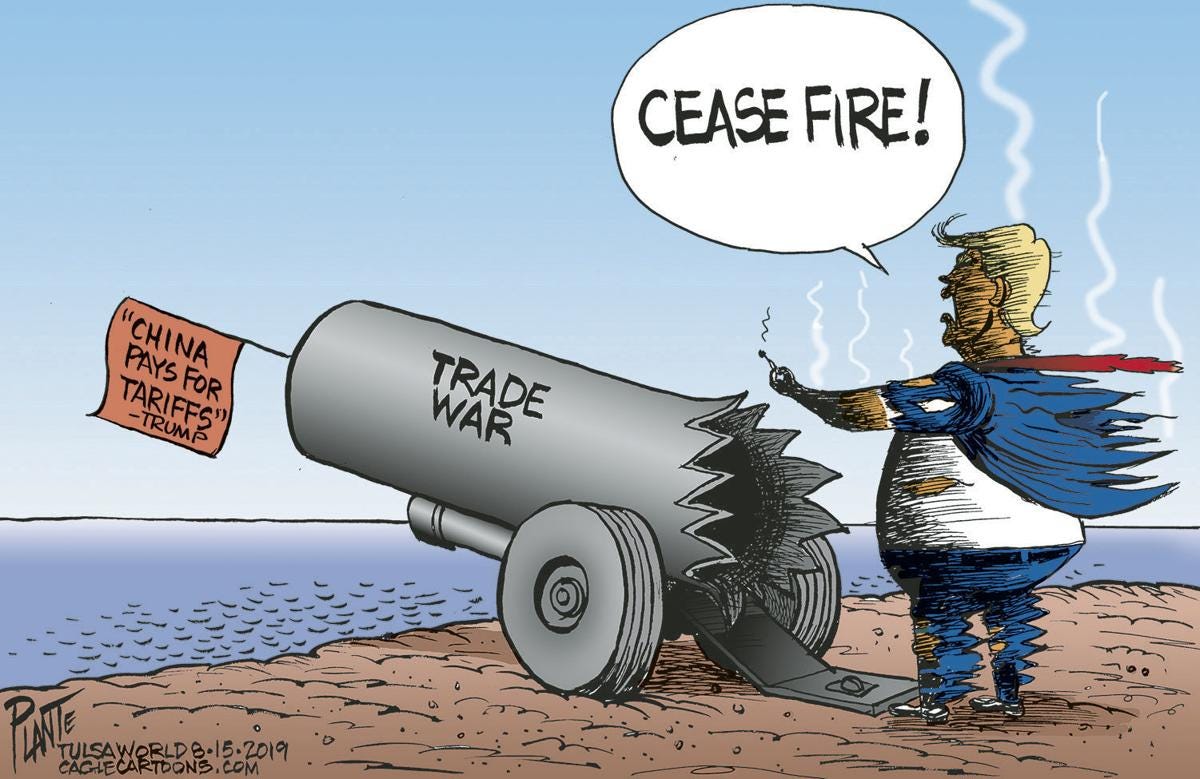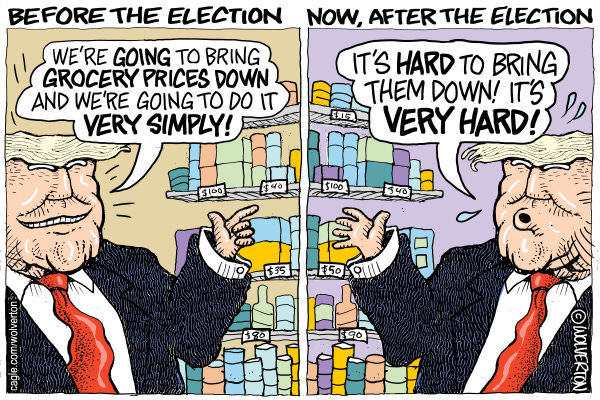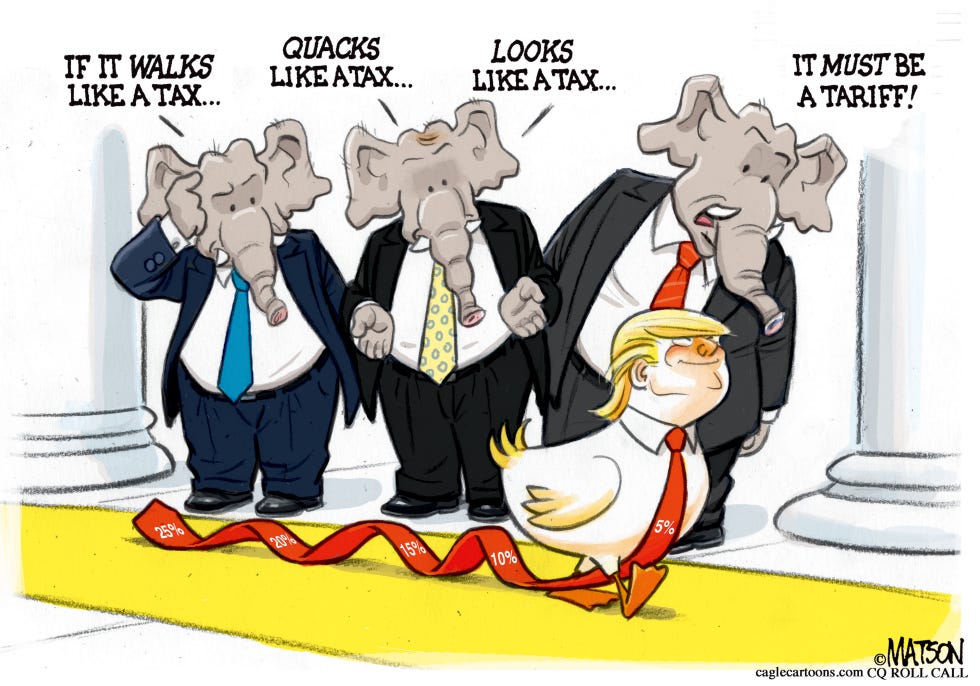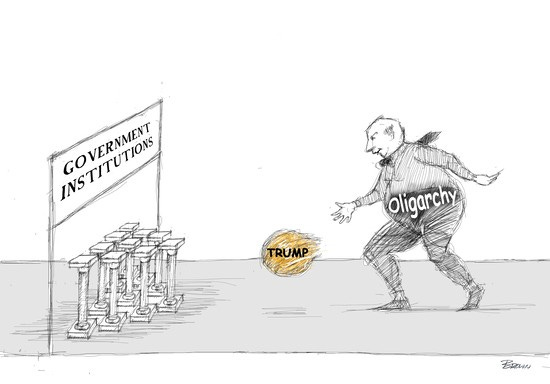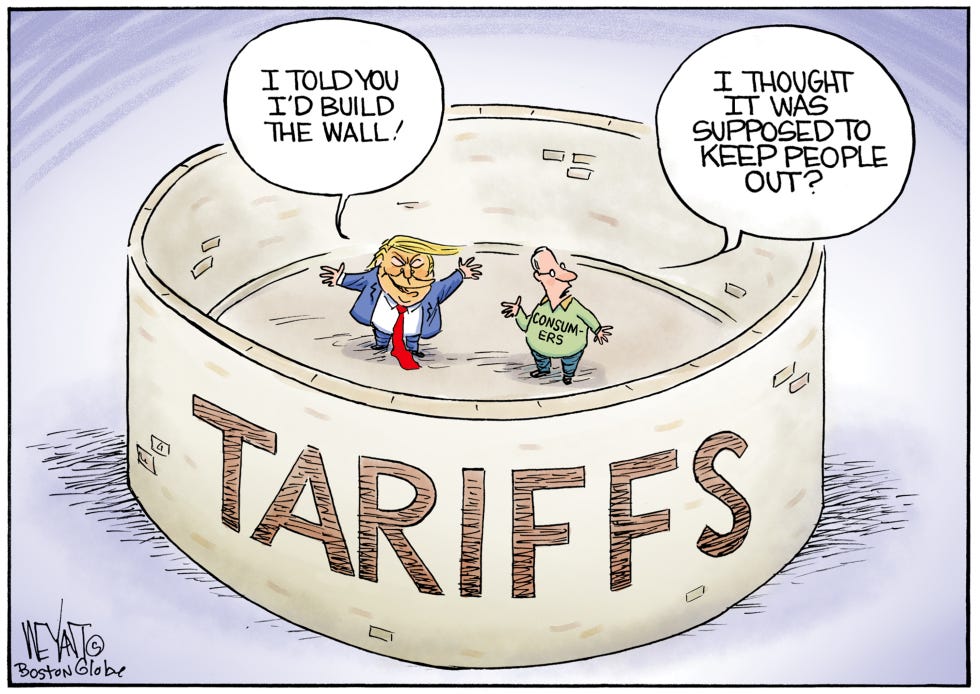Trump's tariff threats, through the lens of the disastrous 1930, Smoot-Hawley Tariff Act
This doesn't end well
Dear TAT readers,
Welcome to the last week before the end of the year holidays. As we get ready to transition into 2025 and a new Trump administration, let’s take a good look at the sheer, staggering idiocy of his campaign pledge to start a global tariff war. We’ve been here before and it was called the Smoot-Hawley Tariff Act. It was a primary factor that led us into The Great Depression, a World War and the most disruptive period in modern US and world history.
For those that pay attention, history is often painfully instructive if left unheeded. It wasn’t just tariff wars started by the US of the 1930s that laid devastating economic pain onto the backs of America’s working classes. Unregulated and poorly regulated greed contributed their fair share as well. The 1930s all together have some pronounced parallels to the America we now live in. Tariff wars are but one of those parallels. All combined, those same parallels represent acute threats to not only working-class Americans but to our republic itself.
During the Roaring Twenties, post WW I, America was prosperous, hopeful and on the rise. The 20’s also was full of excess, greed by elite wealth and poor working classes, much as described in The Great Gatsby. The Stock Market crash of 1929 and the 1930 Smoot-Hawley Tariff Act brought all of this to an end, not only for the US but the globe. The Great Depression ushered in the 1940s , which saw the globe fully immersed in WW II and the beginning of the Cold War. Twenty years of intense global upheaval literally shook the world. Nothing would ever be the same again. If you consider the Great Depression as a precursor to WW II, then Smoot-Hawley was a primary cause of the Great Depression. Let that sink in.
The political landscape of the 1930s, was as diverse and active as at any time in our history. The Great Depression spawned a very large number of progressive movements and even a fairly strong socialist movement, both in pursuit of protecting the workers who had suffered badly from a lack of employment. It also spawned a far larger American Nazi movement and high-profile KKK public activity.
Today, diverse and contrary political movements include many as fascist as those of Nazi Germany, Italy and Japan, or as forward-leaning in support of American workers as today’s progressives. Unlike the 1930s, today’s political landscape does not include the record high 900,000 enrolled in Socialist movements that we saw up until 1932. By the late 1930s, the socialists were mostly gone but the American far-right movements lasted up until the day that America declared war on Germany, post, Pearl Harbor. Today, the fascists still exist in the form of MAGA and related movements, while that socialism is still mostly absent from any significance on the American political landscape. Those on today’s political spectrum that work to protect workers almost always come from the political left, progressive or otherwise.
Today though, is about tariffs and how they are always mentioned as one of those most prominent causes of the Great Depression.
Smoot-Hawley was a bill designed in theory, to protect American agriculture from foreign competitors. In the end, it hurt both deeply. This protectionist measure also played out against a backdrop of a deep American commitment to isolationism, as the rest of the world slowly but unstoppably marched towards a world war.
The Hawley- Smoot Tariff and the Great Depression, 1928– 1932 In the 1920s, the focus of trade policy shifted from protecting manufacturing to protecting agriculture. Congress struggled to fi nd the right way to assist farmers and relieve farm distress, turning to a tariff revision after President Coolidge vetoed price- support legislation. The resulting Hawley- Smoot tariff of 1930 proved to be the most controversial piece of trade legislation since the Tariff of Abominations in 1828. The subject of heated debate during its difficult passage through Congress, the legislation helped push the average tariff on dutiable imports to near- record levels just as the economy was sliding into the Great Depression. The early 1930s saw an unprecedented contraction of world trade, during which time many other countries retaliated against the United States and significantly increased their own trade barriers. The Hawley- Smoot tariff had far- reaching consequences and it marked the last time that Congress ever set duties in the entire tariff schedule. - Clashing over Commerce: A History of U.S. Trade Policy - This PDF is a selection from a published volume from the National Bureau of Economic Research - Volume Author/Editor: Douglas A. Irwin - November 2017
The bottom line to Smoot-Hawley and presumably President-elect Trump’s threats against our neighbors and most other nations, is that tariffs start tariff wars, in which there are no winners. Also, it is working Americans that do the overwhelming majority of the suffering. At the moment, toxic oligarchy is keeping the prices of goods and services artificially inflated. No, not inflation, but just plain and simple, old-fashioned price-gouging.
There is legitimate fear of Trump’s approach to the economy. First of all, he’s inheriting President Biden’s hot, well-grounded economy, just like he did in 2016 from the Obama administration. He has already told us that he doesn’t think it will be easy to lower consumer prices and as we all have learned during his 2018, losing trade war with China, it is the American people who pay the cost of tariffs.
Introduction to the research from the National Bureau of Economic Research “The ghost of Smoot-Hawley seems to haunt President Trump.”1 As fears of a trade war between the U.S. and China grew after the U.S. presidential election of 2016, many commentators drew precisely this link between the events of 1930 and today. And the consensus was that the trade wars of the 1930s were an ominous portent of what might await the world if Donald Trump’s protectionist impulses were not checked The conclusion of the research from the National Bureau of Economic Research President Trump’s recent use of tariffs as a “weapon” to cudgel other nations into changing their trade policies has renewed interest in understanding what trade wars are and how they affect flows of goods and services across borders. As our research indicates, the current trade war was by no means the first one initiated by the U.S. The passage of Smoot-Hawley led to direct retaliation by important U.S. trade partners. Countries responded to its passage by imposing tariffs 24 targeting U.S. exports. Although protectionism was on the rise in the 1930s, we collect novel data and design empirical tests which show that retaliation against Smoot-Hawley was distinctive: it involved policies specifically directed at the U.S., the initial provocateur. Using a new data set on quarterly bilateral trade flows as well as detailed information on who filed official protests during the legislative debate over the Tariff Act of 1930 and who (later) retaliated, gravity model estimates demonstrate that U.S. exports were severely affected by the Smoot-Hawley trade war. Even after controlling for financial crises, the effects of the global decline in aggregate demand, and the overall decline in partner countries’ imports from all sources, U.S. exports fell substantially. If they had just fallen in line with the overall reduction in imports in each country, we would have found no effect: instead, they fell disproportionately, by between 15 and 33 percent, depending on the specification and the countries involved. By examining the effects for protestors as well as retaliators, we are able to more extensively assess the retaliation against Smoot-Hawley: this was not limited to those countries traditionally regarded as “retaliators”. Product-level regression estimates confirm that retaliators were strategic in their response to Smoot-Hawley (as they have been in more recent trade wars), choosing to bludgeon key U.S. exports differentially. Fast-growing U.S. exports of automobiles appear to have been particularly targeted by U.S. trade partners. Our results suggest that MFN constraints did not prevent countries from effectively retaliating. In addition to strategically targeted tariffs, retaliation involved such non-tariff measures as quotas, boycotts and increased sales resistance to American goods. Our results show that this retaliation was extremely effective in reducing U.S. exports. In March 2018, Peter Navarro famously predicted that no country would retaliate against U.S. tariffs. 29 The evidence from the 1930s suggests it is a mistake, even for a country as wealthy and powerful as the United States, to assume that it can engage in a trade war with impunity. - THE SMOOT-HAWLEY TRADE WAR- NATIONAL BUREAU OF ECONOMIC RESEARCH - Kris James Mitchener - Kirsten Wandschneider - Kevin Hjortshøj O'Rourke - March 2021
To wrap up this short history lesson, I wish to remind readers that trade wars rarely achieve their desired effect and more often than not… backfire. Tariffs are always paid by the consumer, not the companies involved in the import/ export of products. Projections for Trump’s intended tariffs suggest an increase of at least $1,900 a year for the average family although depending on the products and services used, it could easily be five times that. In an economy where consumers are already being abused at the cash register, such additions to family budgets are not only unwelcome, but could negatively impact other important budget items.
Most families do not have room in their budgets to fight trade wars that make the oligarchical elite, wealthier, while their budget becomes overburdened because of tariffs. This is why tariffs are often described as a “tax” on consumers.
What is a tariff and what is its function? A tariff is a tax placed on goods when they cross national borders. The most common type is an import tariff, which taxes goods brought into a country. There are also export tariffs, which are taxes on goods a country exports, though these are rare. The United States does not allow export tariffs; the Constitution (Article I, Section 9) forbids them. - USCDornsife - College of Letters, Arts and Science
If Trump’s administration of toxic oligarchs, don’t understand the Smoot-Hawley debacle for the US, their current stated plans, have every opportunity to repeat this disastrous history, on a grand scale. As always it is us, the average citizens that pay the price, whether it is in our wallets or especially if trade wars evolve into actual conflicts, as they did in 1939. The world is at significant threat for actual major conflict if intelligent diplomacy is not employed. With Richard Grenell, Trump’s special envoy and a globally despised Trump attack dog, hand-picked to be turned loose against the world, all bets are off.
Let’s not forget that Putin promised a “new world order” the day after our election. Should that order be any combination of Putin, Xi, Modi and Trump, the odds that there will be conflict, increase. I can’t think of a single American citizen that wants to pay more to make oligarchs wealthier and then potentially go to war to protect their riches. This is the type of administration shaping up in our nation’s capital. It’s got nothing to do with our constitutional principles or our stated values. It is simply a giant power-grab for the few, paid for by the rest of us in dollars and potentially blood.
It is on days like today that I am grateful to be the son of a history teacher. Sitting at my father’s bookshelves from the time I could read, helps me “pay-it-forward” by sharing what I have learned, with you. We don’t all have to be historians. We must though be responsibly informed citizens who not only understand our history, but the very constitutional republic we live in. Not one thing in our founding documents, foresaw a Trump-like figure in our future. Our SCOTUS with six far-right Justices, avoidant of our constitutional principles are largely to blame for allowing another Trump administration via a variety of decisions, especially the one regarding presidential immunity.
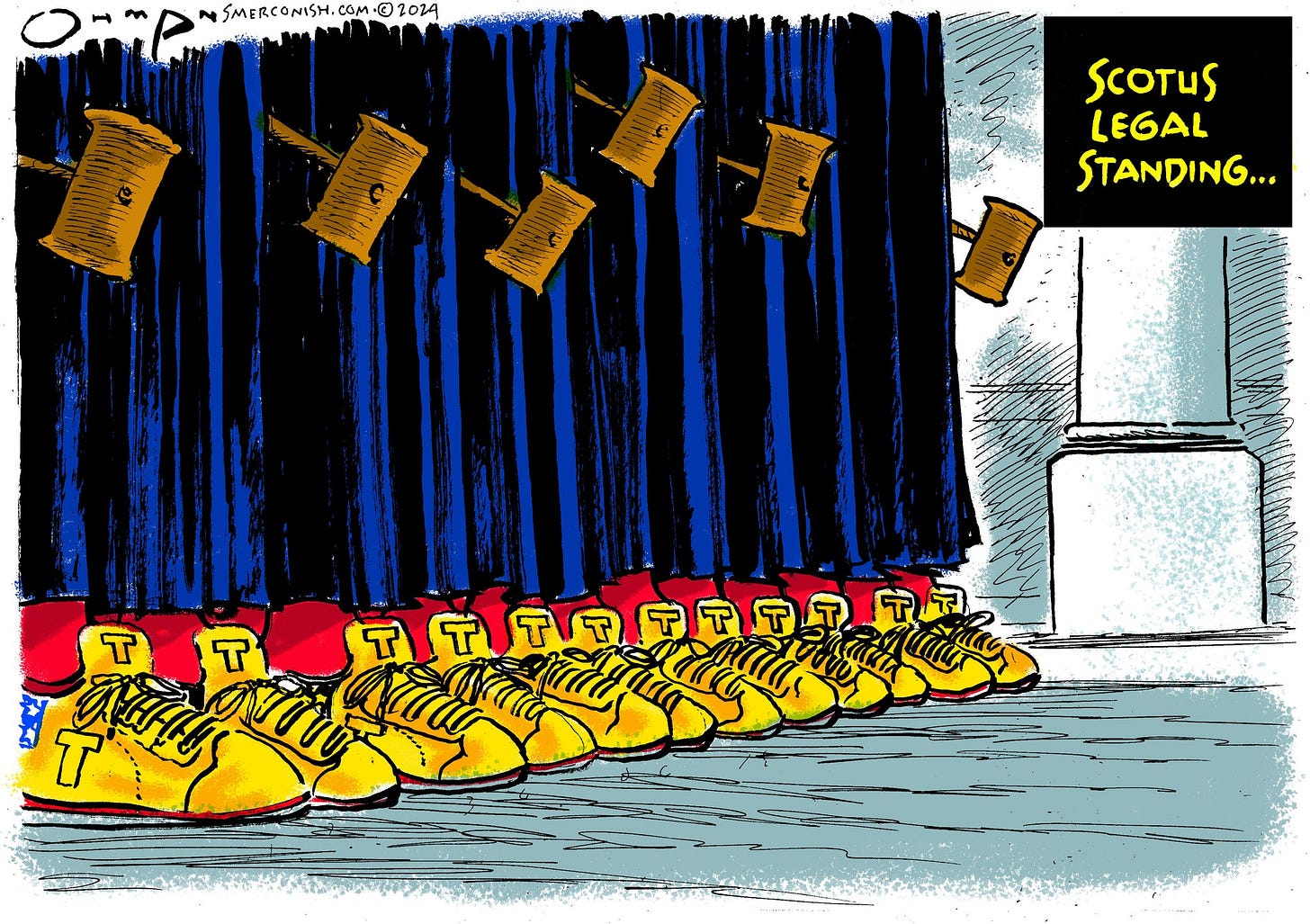
The last line of defense for our republic, are those of us that still respect our founding principles and that will act to restore them fully, from Trumpian usurpers. So, my friends, I am deeply grateful that you read these little historical tales a couple of days a week. Our history is far from perfect, but our founding principles pretty much are. The Trump era isn’t a step backwards, but countless steps so. One day, the history of this era will be a dark, red stain on the family legacies of those of the MAGA movement. It will also be the history that teaches us how to prevent another era similar to the Four Horsemen of the MAGA Apocalypse, Autocracy, Oligarchy, White Christian Nationalism and Political Violence.
As it pertains to history, a famous Spanish-American philosopher, poet, essayist and novelist by the name of George Santayana is quoted as saying: “Those who cannot remember the past are condemned to repeat it.” In a 1948 speech to the House of Commons, Winston Churchill converted this to his famous quote: “Those who do not learn from history are doomed to repeat it.” Either way, the Smoot-Hawley history should never be repeated, for everyone’s sake. If only Trump would listen.
My very best for your week,
Paul


